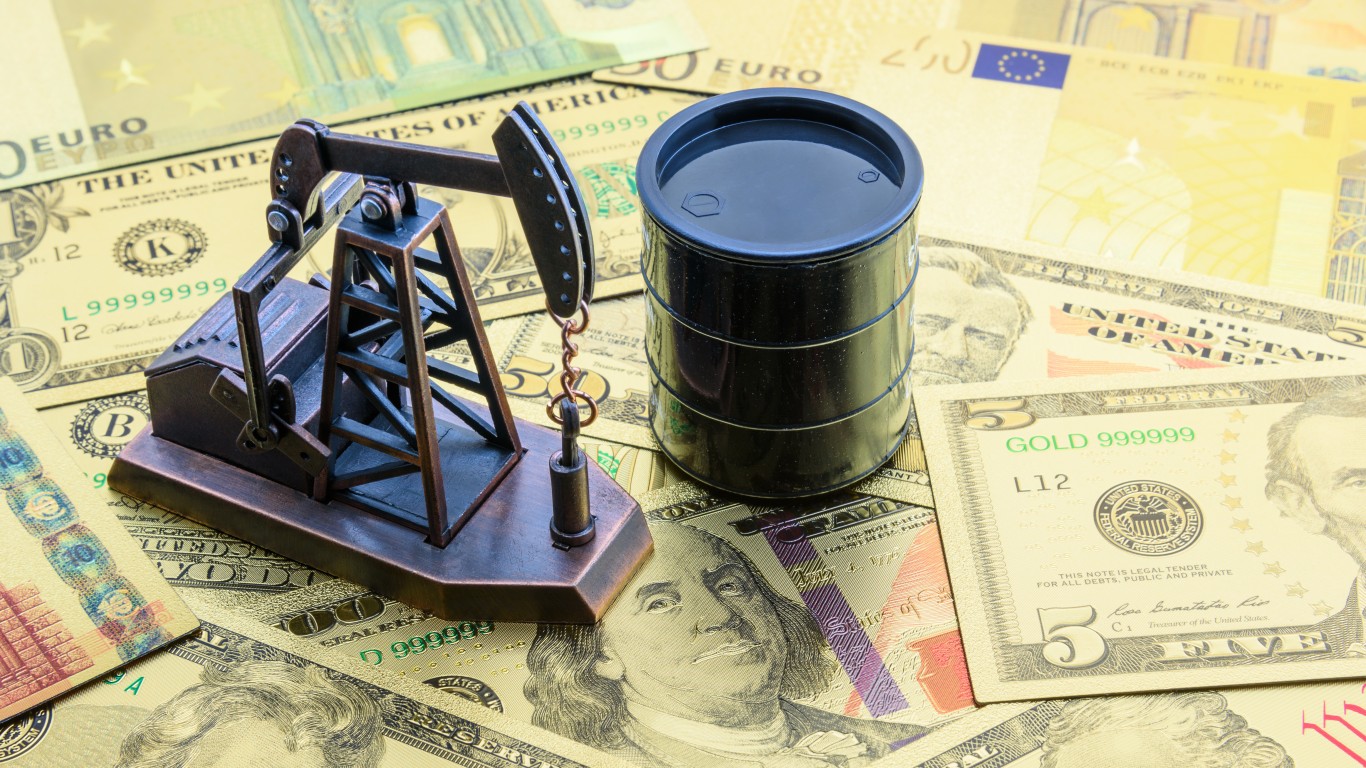
Since touching a low of around $36 a barrel in late October, West Texas Intermediate (WTI) crude oil has added just over $16 to trade up by 46% as of Monday’s closing price. Over the same period, the share prices of six independent oil and gas exploration and production (E&P) companies have increased by a mean average of 93%.
Investors clearly believe that oil prices are set to go even higher this year as the world recovers from the COVID-19 pandemic and national economies emerge from the steep plunges of 2020. Ironically, perhaps, shares of electric vehicle (EV) makers have improved even more. Two of the hottest EV stocks, Tesla and Nio, have both doubled since last October.
[in-text-ad]
EV stocks are a medium-term to long-term play while oil and gas E&P stocks are short-term to medium-term plays. The former represent growth stocks with a fabulous year behind them and a bright outlook for several years to come. Whether they are overpriced based on expected revenues and profits doesn’t really figure into a short year-or-two period.
Oil and gas stocks, however, are all about short-term returns, both in share price appreciation and dividend payments. Those returns depend on the commodity price of crude oil and natural gas combined with lower capital spending and reduced costs.
As a whole, the energy sector has lost about 30% of its valuation over the past 12 months. Here’s a look at six E&P companies that have a mean average loss of around 27.5% for the same period but that have, as a group, added an average of 25% to their share prices since the beginning of 2021. Crude has added about 9.3% during the same few days.
Occidental Petroleum
Occidental Petroleum Corp. (NYSE: OXY) has seen its share price rise by more than 29% since the beginning of the year. The stock dropped by 58% last year, but its current spurt has cut that decline in half. Rising crude prices play a role, certainly, but Oxy was the second-worst-performing S&P 500 stock of 2020. Its consensus price target is $16.88, and shares traded at around $21.90 Tuesday morning.
Oxy pays an annual dividend of $0.04 per share (yield of 0.20%) and is tabbed to post a loss of $3.74 a share for 2020 and $1.57 per share in 2021. At a recent price of around $22.10, the potential upside to the 52-week high of $47.58 is 54% and the potential upside to a high price target of $29 a share is nearly 33%. The consensus price target on the stock is $21.90. Mizuho analysts on Tuesday raised their rating on Occidental stock from Neutral to Buy and lifted the price target from $11 to $26.
Marathon Oil
Last year, Marathon Oil Corp. (NYSE: MRO) saw its share price decline by 50%. Since January 4, shares are up nearly 24%. Floating on hopes that crude prices will continue to improve this year, the consensus price target on Marathon’s stock is $7.84, compared to a current price of around $8.20.
Marathon has suspended its dividend and is expected to post a net loss of $0.06 per share in 2021. At its recent price, shares trade about 39% below the 52-week high of $13.47 and 59% the high price target of $13 a share. Mizuho also raised its rating on Marathon from Neutral to Buy and raised the price target from $6 to $11.
Apache
After dropping by nearly 41% in 2020, Apache Corp. (NASDAQ: APA) stock has regained more than half that loss by posting a jump of 25% so far in 2021. The consensus price target is $16.72, and shares recently traded around $17.80.
Apache pays an annual dividend of $0.10 a share and is expected to post earnings per share of $0.36 in 2021. At its recent trading price, the stock has a potential gain of around 47% based on its 52-week high of $33.77 and 63% based on its high price target of $29.
Devon Energy
Devon Energy Corp. (NYSE: DVN) posted a per-share loss of around 35% in 2020 but has recovered about 60% of that loss since 2021 began. The consensus price target on the stock is $19.79, and it traded recently at around $19.40. In September, Devon paid about $2.6 billion in stock for WRX Energy.
[in-text-ad]
The oil and gas producer pays an annual dividend of $0.44 (yield of 2.43%) and is expected to report per-share earnings of $0.07 in 2021. The potential upside on Devon stock, based on its 52-week high of $26.98, is 28%. On the basis of a high price target of $33, the potential upside is 70%.
EOG Resources
In 2020, EOG Resources Inc. (NYSE: EOG) stock dropped by about 39%, but it has risen by 26% since the beginning of the year. Analysts have a consensus price target of $64.42 on the shares, just a bit higher than the current trading price of around $62.20.
EOG pays an annual dividend of $1.55 (yield of 2.55%) and is expected to report earnings per share of $2.43 in 2021. At the current price, the potential upside to the 52-week high of $88.09 is nearly 30% and the potential gain to the high price target of $90 is 45%.
Pioneer Natural Resources
Though Pioneer Natural Resources Co. (NYSE: PXD) posted a 2020 loss of about 23%, it has managed to recover nearly all of it by surging 21% since the beginning of the year. In October, Pioneer paid $4.5 billion in stock for Parsley Energy. The consensus price target on the stock is $139.19, just a dollar higher than its current trading price.
Pioneer pays an annual dividend of $2.20 (yield of 1.67%) and is expected to post earnings per share of $5.69 in 2021. At its current price, the potential gain compared to the 52-week high of $149.54 is about 7.6%. Compared to a high price target of $201, the potential upside from the recent price is 45%.
It is also interesting to look at these six stocks compared to the two U.S. major integrated oil and gas stocks, Exxon and Chevron. Those two saw share prices dip by 27% and 26%, respectively, in 2020. Chevron recovered more than a third of that loss in the first few days of 2021 trading, and Exxon has recovered more than half its loss in all of last year.
But Exxon’s annual dividend of $3.48 (yield of 7.43%) and Chevron’s $5.16 dividend (yield of 5.63%) far outpace any of the independents. One question investors have to ask themselves is how long either or both of these giants can keep paying these massive yields. Another is whether the independents are more or less likely than the giants to see share price appreciation.
So far, the giants seem to be holding their own in price appreciation and are way ahead in dividends. Watch for new ratings and price targets on the independents to begin emerging now that trading prices have outrun targets. Something has to give here.
Get Ready To Retire (Sponsored)
Start by taking a quick retirement quiz from SmartAsset that will match you with up to 3 financial advisors that serve your area and beyond in 5 minutes, or less.
Each advisor has been vetted by SmartAsset and is held to a fiduciary standard to act in your best interests.
Here’s how it works:
1. Answer SmartAsset advisor match quiz
2. Review your pre-screened matches at your leisure. Check out the advisors’ profiles.
3. Speak with advisors at no cost to you. Have an introductory call on the phone or introduction in person and choose whom to work with in the future
Thank you for reading! Have some feedback for us?
Contact the 24/7 Wall St. editorial team.
 24/7 Wall St.
24/7 Wall St.



